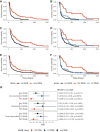Immune-Related Adverse Event Likelihood Score Identifies "Pure" IRAEs Strongly Associated With Outcome in a Phase I-II Trial Population
- PMID: 37715957
- PMCID: PMC10836307
- DOI: 10.1093/oncolo/oyad239
Immune-Related Adverse Event Likelihood Score Identifies "Pure" IRAEs Strongly Associated With Outcome in a Phase I-II Trial Population
Abstract
Background: Immune-related adverse events (IRAE) pose a significant diagnostic and therapeutic challenge in patients treated with immune-oncology (IO) drugs. IRAEs have been suggested to correlate with better outcome, but studies are conflicting. Estimating the true incidence of IRAEs is particularly difficult in the early phase I/II trial setting. A key issue is the lack of IRAE diagnostic criteria, necessary to discriminate "pure" IRAEs from other treatment-related adverse events not sustained by an autoimmune process.
Methods: In patients treated with immune-oncology (IO) drugs in phases I-II trials at our institute, we identified high confidence (HC) or low confidence (LC) IRAEs by clinical consensus. We empirically developed an IRAE likelihood score (ILS) based on commonly available clinical data. Correlation with outcome was explored by multivariate Cox analysis. To mitigate immortal time-bias, analyses were conducted (1) at 2-month landmark and (2) modeling IRAEs as time-dependent covariate.
Results: Among 202 IO-treated patients, 29.2% developed >1 treatment-related adverse events (TRAE). Based on ILS >5, we classified patients in no IRAE (n = 143), HC IRAE (n = 24), or LC IRAE (n = 35). hazard ratios (HR) for HC were significantly lower than LC patients (HR for PFS ranging 0.24-0.44, for OS 0.18-0.23, all P < .01).
Conclusion: ILS provides a simple system to identify bona fide IRAEs, pruning for other treatment-related events likely due to different pathophysiology. Applying stringent criteria leads to lower and more reliable estimates of IRAE incidence and identifies events with significant impact on survival.
Keywords: biomarker; clinical trial; immune-related adverse events; immunotherapy; predictive factors.
© The Author(s) 2023. Published by Oxford University Press.
Conflict of interest statement
Luca Mazzarella reports having a consulting or advisory role for Tethis Inc. Carmen Criscitiello reports personal fees for consulting, advisory role, and speakers’ bureau from Lilly, Roche, Novartis, MSD, Seagen, Daiichi Sankyo, AstraZeneca, Gilead, and Pfizer. Giuseppe Curigliano reports having a consulting or advisory role for AstraZeneca, Boehringer Ingelheim, Bristol Myers Squibb, Daiichi-Sankyo, Eli Lilly, Foundation Medicine, GlaxoSmithKline, Novartis, Pfizer, Roche/Genentech, Samsung, Exact Sciences, Merck and Seagent; having served on speakers bureau for Daiichi-Sankyo, Eli Lilly, Foundation Medicine, Novartis, Pfizer, Roche/Genentech and Samsung; having received travel, accommodations and expenses support from Roche/Genentech, Daichii-Sankyo and Pfizer; having received honoraria from Ellipses Pharma; and having received research funding from Merck. The other authors indicated no financial relationships.
Figures





Similar articles
-
Immune-Related Adverse Events in PD-1 Treated Melanoma and Impact Upon Anti-Tumor Efficacy: A Real World Analysis.Front Oncol. 2021 Nov 26;11:749064. doi: 10.3389/fonc.2021.749064. eCollection 2021. Front Oncol. 2021. PMID: 34900695 Free PMC article.
-
Immune-Related Adverse Events as Clinical Biomarkers in Patients with Metastatic Renal Cell Carcinoma Treated with Immune Checkpoint Inhibitors.Oncologist. 2021 Oct;26(10):e1742-e1750. doi: 10.1002/onco.13868. Epub 2021 Jul 8. Oncologist. 2021. PMID: 34156726 Free PMC article.
-
Association Between Immune-Related Adverse Events and Survival in Patients with Hepatocellular Carcinoma Treated With Atezolizumab Plus Bevacizumab.Oncologist. 2023 Jul 5;28(7):e526-e533. doi: 10.1093/oncolo/oyad090. Oncologist. 2023. PMID: 37023703 Free PMC article.
-
The Inconsistent and Inadequate Reporting Of Immune-Related Adverse Events in PD-1/PD-L1 Inhibitors: A Systematic Review of Randomized Controlled Clinical Trials.Oncologist. 2021 Dec;26(12):e2239-e2246. doi: 10.1002/onco.13940. Epub 2021 Aug 31. Oncologist. 2021. PMID: 34396642 Free PMC article.
-
Analysis of the association between prospectively collected immune-related adverse events and survival in patients with solid tumor treated with immune-checkpoint blockers, taking into account immortal-time bias.Cancer Treat Rev. 2022 Nov;110:102452. doi: 10.1016/j.ctrv.2022.102452. Epub 2022 Aug 10. Cancer Treat Rev. 2022. PMID: 35998515 Review.
Cited by
-
Predictive Biomarkers for Immunotherapy in Gastric Cancer: Current Status and Emerging Prospects.Int J Mol Sci. 2023 Oct 18;24(20):15321. doi: 10.3390/ijms242015321. Int J Mol Sci. 2023. PMID: 37895000 Free PMC article. Review.
-
Adjuvant therapy provides no additional recurrence-free benefit for esophageal squamous cell carcinoma patients after neoadjuvant chemoimmunotherapy and surgery: a multi-center propensity score match study.Front Immunol. 2024 Feb 5;15:1332492. doi: 10.3389/fimmu.2024.1332492. eCollection 2024. Front Immunol. 2024. PMID: 38375480 Free PMC article.
-
Characterising immune-related adverse events in different types of cancer among Chinese patients receiving immune checkpoint inhibitors.Sci Rep. 2024 Dec 28;14(1):30983. doi: 10.1038/s41598-024-82105-3. Sci Rep. 2024. PMID: 39730637 Free PMC article.
-
Biomarkers and ImmuneScores in lung cancer: predictive insights for immunotherapy and combination treatment strategies.Biol Proced Online. 2025 Jul 10;27(1):25. doi: 10.1186/s12575-025-00287-0. Biol Proced Online. 2025. PMID: 40640703 Free PMC article. Review.
-
Non-Invasive Predictive Biomarkers for Immune-Related Adverse Events Due to Immune Checkpoint Inhibitors.Cancers (Basel). 2024 Mar 20;16(6):1225. doi: 10.3390/cancers16061225. Cancers (Basel). 2024. PMID: 38539558 Free PMC article. Review.

